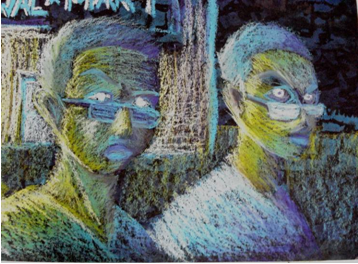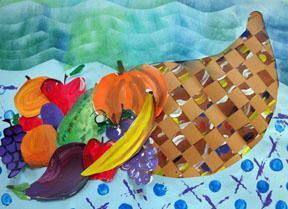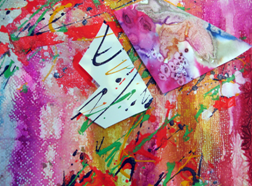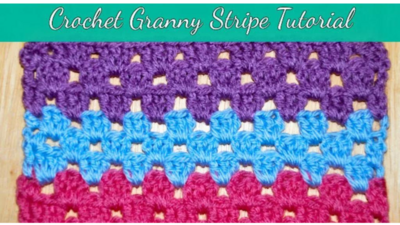Expressive Oil Pastel Portraits

Target Grade: 9-12
Goal (Terminal Objective): Students will create double expressive self portraits with at least one head in a ¾ pose combining homework drawings and previously made background and a frontal practice portrait with this lesson from Sargent Art. Students will use color and textures in oil pastel painting to represent form and space in the manner of Vincent van Gogh and Paul Gaugain. Students will demonstrate understanding of asymmetrical balance and movement in composition and accurate proportions in drawing self.
Objective: The student will develop painting skills working with large and small pastels on a previously painted or printed background. Student will demonstrate knowledge of line quality, value, form, and texture. The student will distinguish realistic painting from a painterly style. Student will combine several drawings to complete an asymmetrical composition showing understanding of contrast, balance, emphasis, and unity. The student will recognize how color can show form and space and will be able to mix and adapt a color scheme from a famous Modernist painting.
National Standards:
Visual Arts Grades 9-12 Content Standard 1: Understanding and applying media, techniques, and processes
Visual Arts Grades 9-12 Content Standard 4: Understanding the visual arts in relation to history and cultures
Visual Arts Grades 9-12 Content Standard 6: Making connections between visual arts and other disciplines Math and Social Studies Cross Curriculum Connection
Purpose: Students will use medium of oil pastels in three forms as an easy to use painting medium. Students will use higher level thinking skills as select two self portraits and other images to express themselves and/or their interests. Students will identify asymmetrical balance in composition and incorporate the principle of movement. Students, in finding a color scheme and attributes of color from a late 19th century or 20th century painting, will discover how these painters used more intense colors than earlier painters. Students will learn to layer and mix color.
New Vocabulary: expressive, painterly, ¾ pose, proportion, form, line quality, emphasis, asymmetrical balance, space, layering, dominant elements, movement, carbon paper, iris, study
Materials:
- Mirror
- 12” by 18” or larger and 9” by 12” construction paper in black or brown
- Sargent Art Artist’s Oil Pastels in large and regular sizes
- Gallery Metallic Oil Pastels
- newsprint
- carbon paper
Time: This lesson may be modified to last from 5 to 10 hours, depending upon size and complexity.
Introduction and Motivation (Set): View examples of self portraits and portraits. Focus on ¾ pose expressive self portraits by Leonardo da Vinci, Paul Gaugain, Vincent van Gogh, and Henri Matisse. Discuss portraiture as subject matter, pose, and mathematical relationships of parts of face.
Discuss how examples use elements of art: line, form and texture, and principles of design emphasis, balance, unity, movement, and contrast.
Demonstrate oil pastel as an opaque painting medium that is applied in layers to build up form and textures. Compare works of Leonardo as realistic as well as expressive and works of Gaugain and van Gogh as expressive and painterly. Relate painterly style and use of intense color to history of 19th century as period when photography was invented and artists’ responded. Teacher shows how these works from the Modernist and later periods differ in color and use cool colors to shade or show deep space rather than shades or duller colors.
Instruction:
Teacher refers students to Self Portrait by Paul Gaugain and compares to examples of famous portraits previously shown. Students assigned homework to draw a place or object for their sketchbook that describes them as seen in Gaugain’s portrait. Teacher notes patterned background in Gaugain and Matisse’s work; students will use a previously printed patterned composition as their background.
Teacher completes a rough draft on 12” by 18” newsprint of a ¾ pose, use of artist’s rule to measure facial proportions, and placement of parts of face; teacher compares proportions to examples of additional famous portraits in students’ textbook Exploring Painting citing basic guidelines for ¾ pose. Students instructed to turn head enough to see edge of nose which makes nose easier to draw. Teacher tells students that both eyes will show, but closer eye will be larger. Portrait must be life-sized and include neck and shoulders. Teacher reminds students of rules of drawing a ¾ portrait.
• eyes in center of head
• bottom of nose almost halfway from inside corner of eye and bottom of chin
• bottom of lip halfway from underside of nose and chin
• face width of five eyes, bridge of nose width of single eye or two fingers
• only one ear appears, contour line of nose appears
• iris of larger eye appears closer to ear
• iris of eyes goes from top to bottom of eyelids
Teacher demonstrates making at least two thumbnail drawings to plan composition incorporating rough draft portrait, homework assignment, and classroom practice frontal drawing completed earlier. Thumbnail must show asymmetrical balance, space, emphasis, and movement. Teacher demonstrates use of carbon paper to transfer individual parts of composition based on thumbnail to 12” by 18” paper. The ¾ pose or focal point is transferred to the 9” by 12” paper. Teacher reminds students to tape down image to be copied in two places. No tape on carbon paper.
Teacher demonstrates color selection, seeking student input in locating a painting in Exploring Painting or other source for a color scheme. Painting source must include color or colors already present in the printed background. Source is written on same page as thumbnails for future reference. Teacher stresses that colors of skin and/or hair are often non-representational in modernist painting. The color source they select refers to colors only, not subject matter. A landscape could very possibly contain a color scheme that student would choose to use.
Option: Teacher draws and labels a color wheel on sketchbook size paper and places on wheel only colors and values from source chosen to assist students in mixing colors. Note: depending on level of student and previous color theory, students may work out their own color scheme.
Activities:
(1) Guided Practice:
1. Students use pencil or marker to begin a rough draft of ¾ life-sized portrait. Students use larger mirror, artist rule to draw, and measure relationships of parts of face following guidelines working for accuracy.
2. Students make at least two thumbnail sketches to plan composition to include both portraits and drawing for background. (Example of a background drawing below.) Students get teacher approval for best thumbnail and, following thumbnail composition, uses carbon paper to transfer each image to previously printed background.
3. Students transfer ¾ portrait a second time to 9” by 12” sheet (a study) in sketchbook. Students read Exploring Painting text p. 112 and/or observe painterly pastel application in work of Edgar Degas. Students begin layering in color according to color scheme with Sargent Art Large Size Oil Pastels. Students work with two colors or a light and medium color throughout the pastel application. Black pastel is never used.
4. When study is successfully completed, students begin adding color to final composition according to color scheme with large oil pastels. Students use Sargent Art Oil Pastels, a smaller size, for tiny details such as lines between lips and nose area. Students create emphasis, movement, balance, and contrast with Gallery Metallic Oil Pastels.
(2) Independent Practice and Check for Understanding: Teacher circulates among working students observing students demonstrating understanding of objectives and providing reinforcement to students as necessary.
(3) Closure: Students copy assignment rubric in sketchbook checking the following:
Technical -- Oil pastel application is painterly, layered, and demonstrates craftsmanship in use of media; naturalistic facial features accurately drawn from observation
Elements -- lines thick to thin; dominant color scheme accurately follow colors in chosen example; colors create form
Principles -- form and color emphasize face; texture, lines, and background space create contrast; Composition is balanced with shapes and forms; movement achieved with color and contrast; Printed background paper color is repeated in oil pastel application to create unity.
Evaluation:
Level One -- Portrait demonstrates complete understanding and high level of success in completion of all parts of assignment rubric.
Level Two -- Portrait demonstrates understanding and success in completion with need for more dominance in assigned elements and principles and/or minimal errors in craftsmanship or drawing.
Level Three -- Portrait is complete but demonstrates limited understanding of elements and principles assigned and/or need for more practice in drawing and craftsmanship.
Level Four -- Portrait is complete with lack of understanding of elements and principles assigned. Skill and craftsmanship are poor.
Extensions: Loose application of Sargent Art Glitter Glue can add highlights.
Read NextThanksgiving Cornucopia








